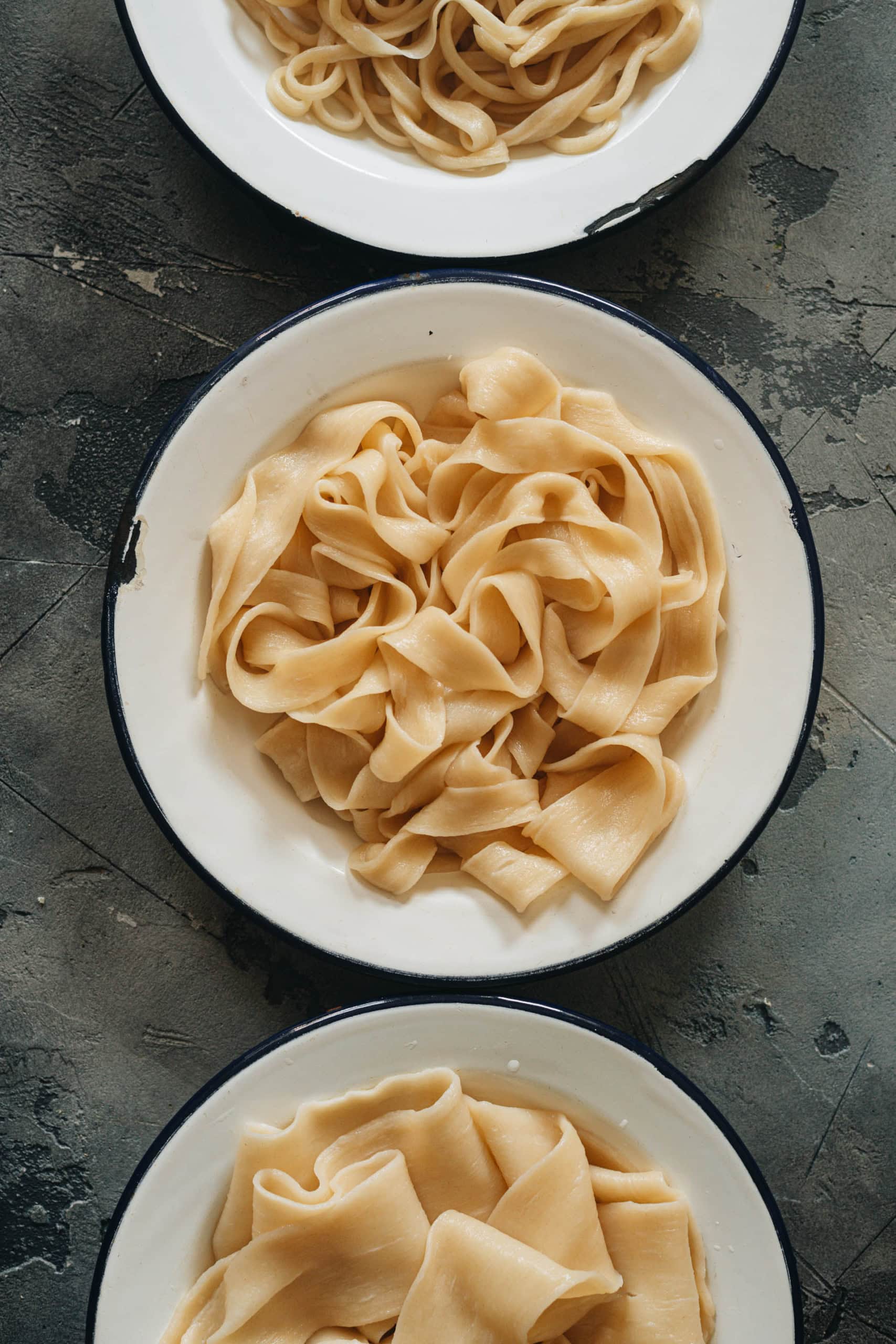
Noodles are one of the core elements of Chinese food culture, and they show up in many of my Authentic Chinese noodle recipes for that reason. Handmade noodles might be a rarity, and even a pricey proposition outside of China. However, back in the old country, they are a cheap everyday comfort food. No matter whether it’s a hot bowl of noodles in a restaurant or freshly made noodles to cook at home, it is one of the cheapest ways to get a fast, fulfilling, and hearty one-dish meal.
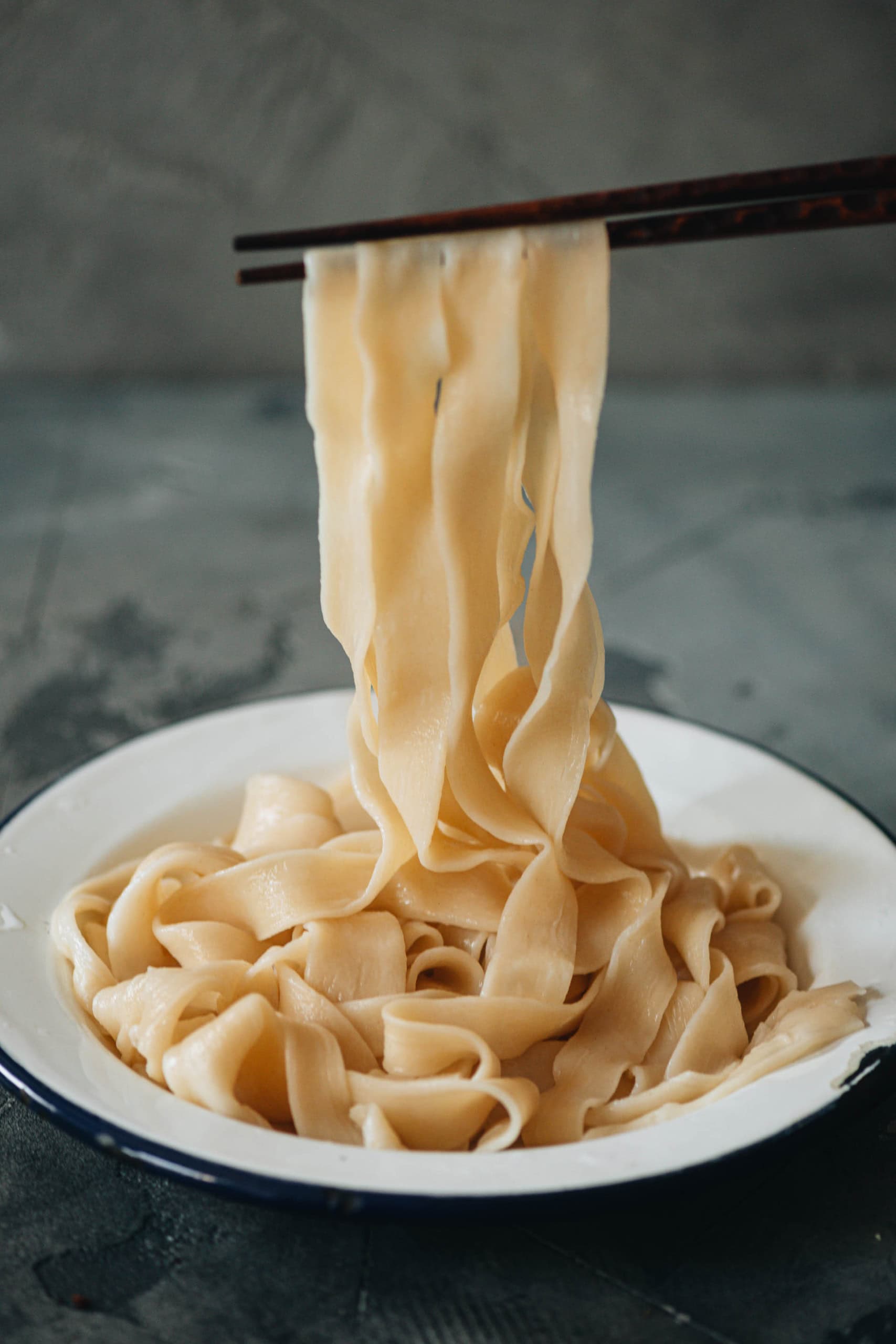
Why make hand pulled noodles at home
Despite the low cost of noodles at restaurants, a lot of people still enjoy making them from scratch at home. The reason? Because:
- It’s just so easy to make hand-pulled noodles once you’ve learned the trick.
- Homemade noodles don’t contain any additives. Packaged fresh noodles usually have additives for a better mouthfeel and a longer shelf life.
- The freshly made noodles taste so good, much better than the packaged dried ones.
There are countless types of noodles in China and I will introduce you to the hand-pulled (拉面, la mian) variety. It might sound daunting to make this type of noodle at home, especially if you’ve ever watched a noodle dance in China. But the truth is, hand-pulled noodles are one of the easiest handmade noodles for a beginner to make.
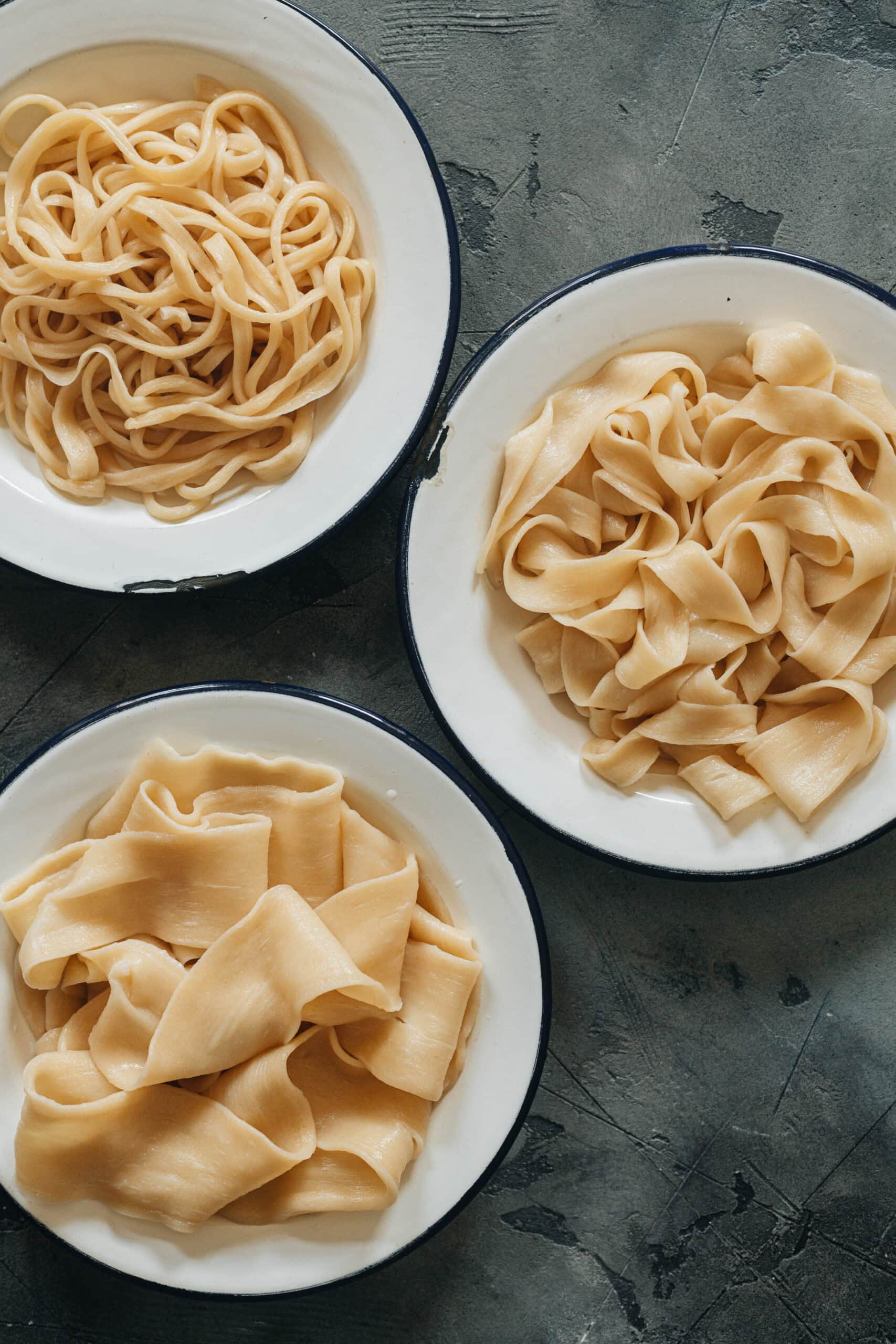
Why this recipe
- A fool-proof recipe that works even if you never made hand pulled noodles before.
- The dough requires minimal kneading and it’s easy to put together.
- The recipe only uses three simple ingredients – flour, salt, and water.
There are two different approaches to making hand-pulled noodles. In most professional kitchens, the most common way is to knead the dough for a very long time to develop the gluten, then let it rest for even longer so the dough is relaxed enough to pull.
However, we found that method not practical in the home kitchen since no one wants to knead the dough for an hour (it takes a similar amount of time, even with a KitchenAid mixer).
After many test runs, we found that the key to making hand-pulled noodle dough is to knead just enough to get the dough smooth without developing too much gluten. So you do not need to rest the dough for too long before pulling. Our method requires very little active kneading, and it will yield a soft and springy dough that’s very easy to work with.
How to make hand-pulled noodles
(1) Prepare the dough – 1 short rest
To make the dough without developing too much gluten, you will need to rest the dough three times before pulling the noodles.
- Slowly drizzle the salt water into the flour and mix at the same time.
- Mix until the water is fully incorporated and the flour turns into shaggy threads.
- Start to knead the dough together.
- If there’s still some dry flour left, drizzle in a bit more water until there’s no dry flour left.
- Once you mix the flour and water, only knead the dough for 2 minutes until it forms a very rough ball. Do not overwork the dough.
- Let the dough rest for 20 minutes before kneading it again, for just 1 to 2 minutes, until the dough becomes smooth.
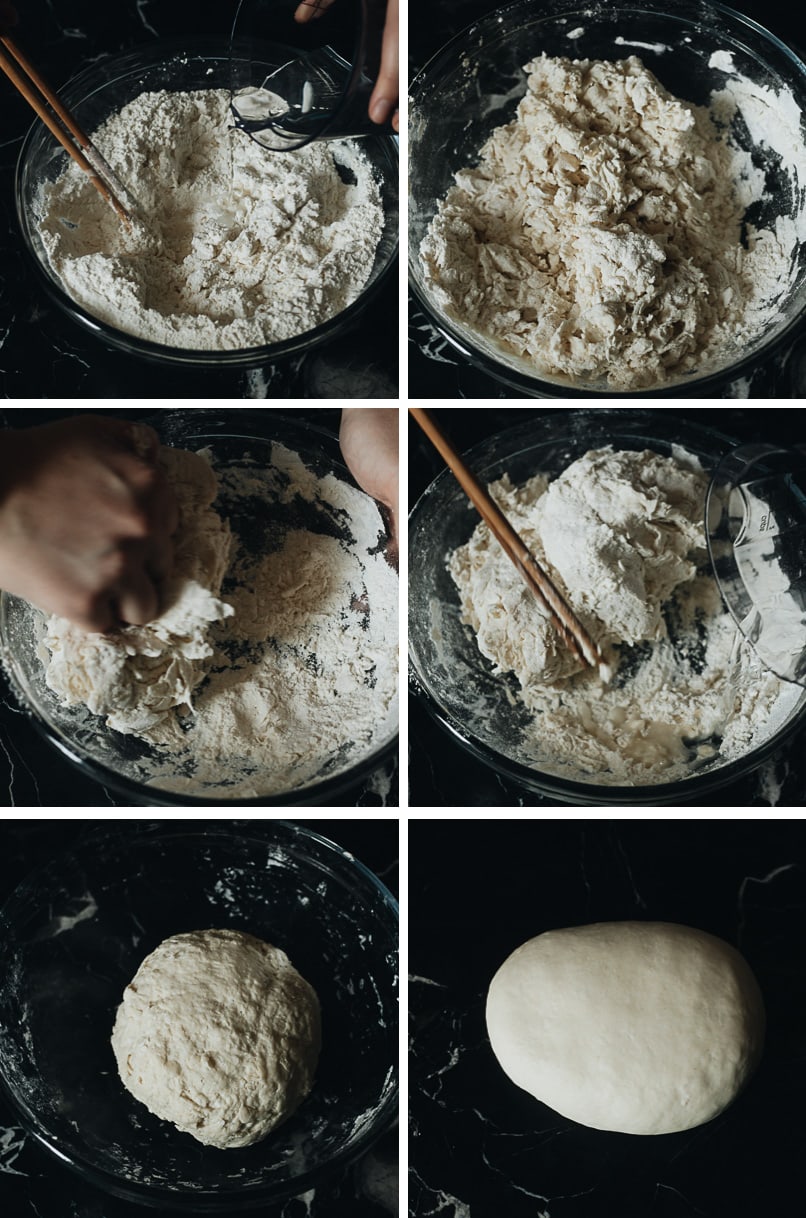
(2) Shape the dough – 2nd resting
Roll out the dough depending on the type of noodles you want to make and let it rest for 2 hours to fully relax the gluten before pulling and cooking.
We’ve included three types of noodle doughs in this recipe, so you can choose the type you prefer:
- Thin noodles: great for noodle soup, fried noodles, or lo mein noodles
- Flat noodles: good for noodle soup or noodles served with a sauce
- Wide noodles: good with a super heavy sauce such as cumin lamb or da pan ji
NOTE: it’s important to oil the dough and cover it, to prevent them from sticking and drying out.
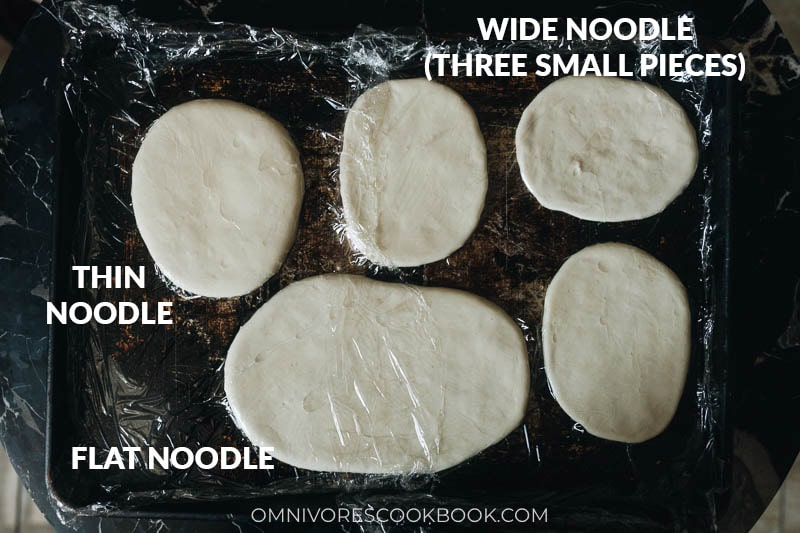
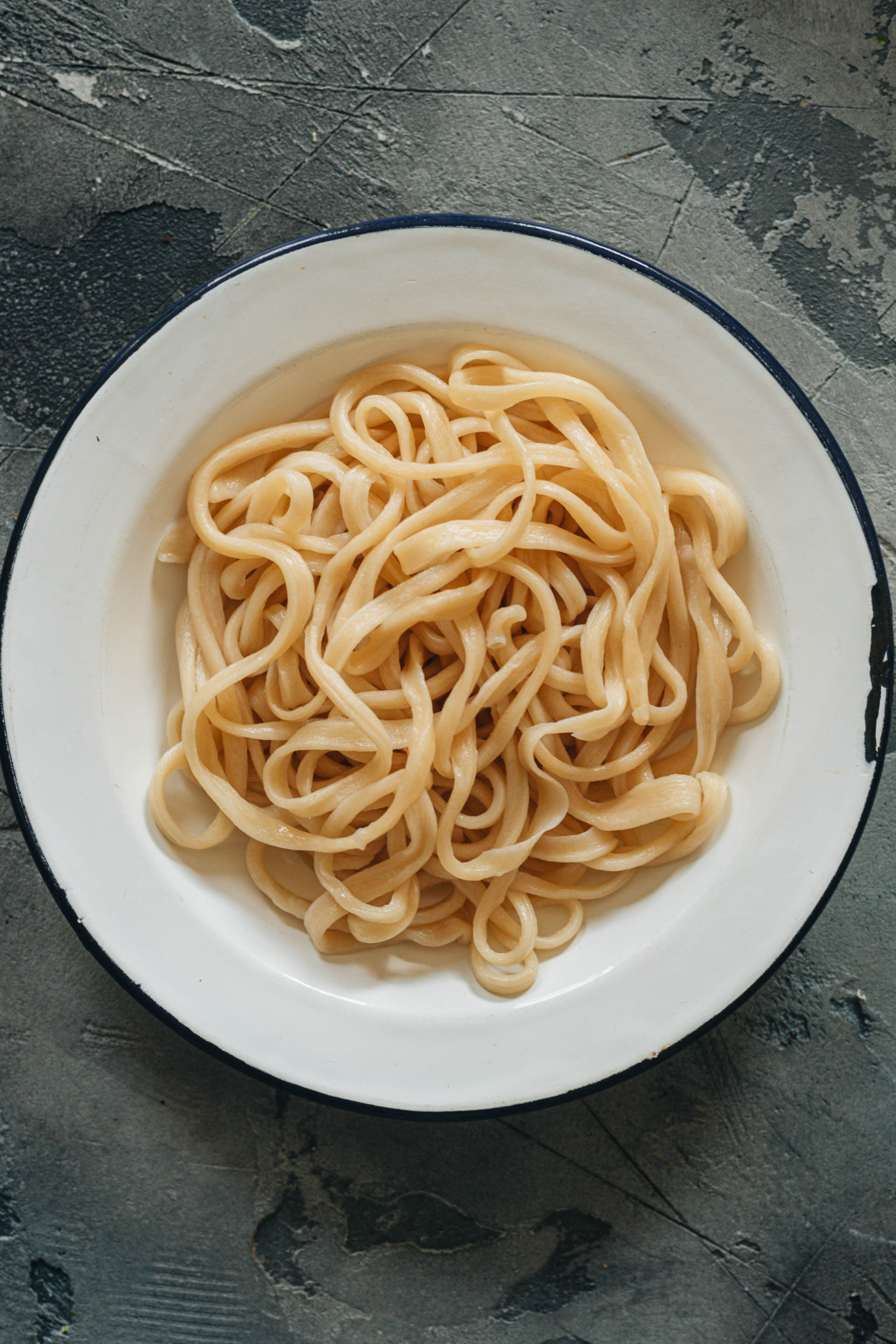
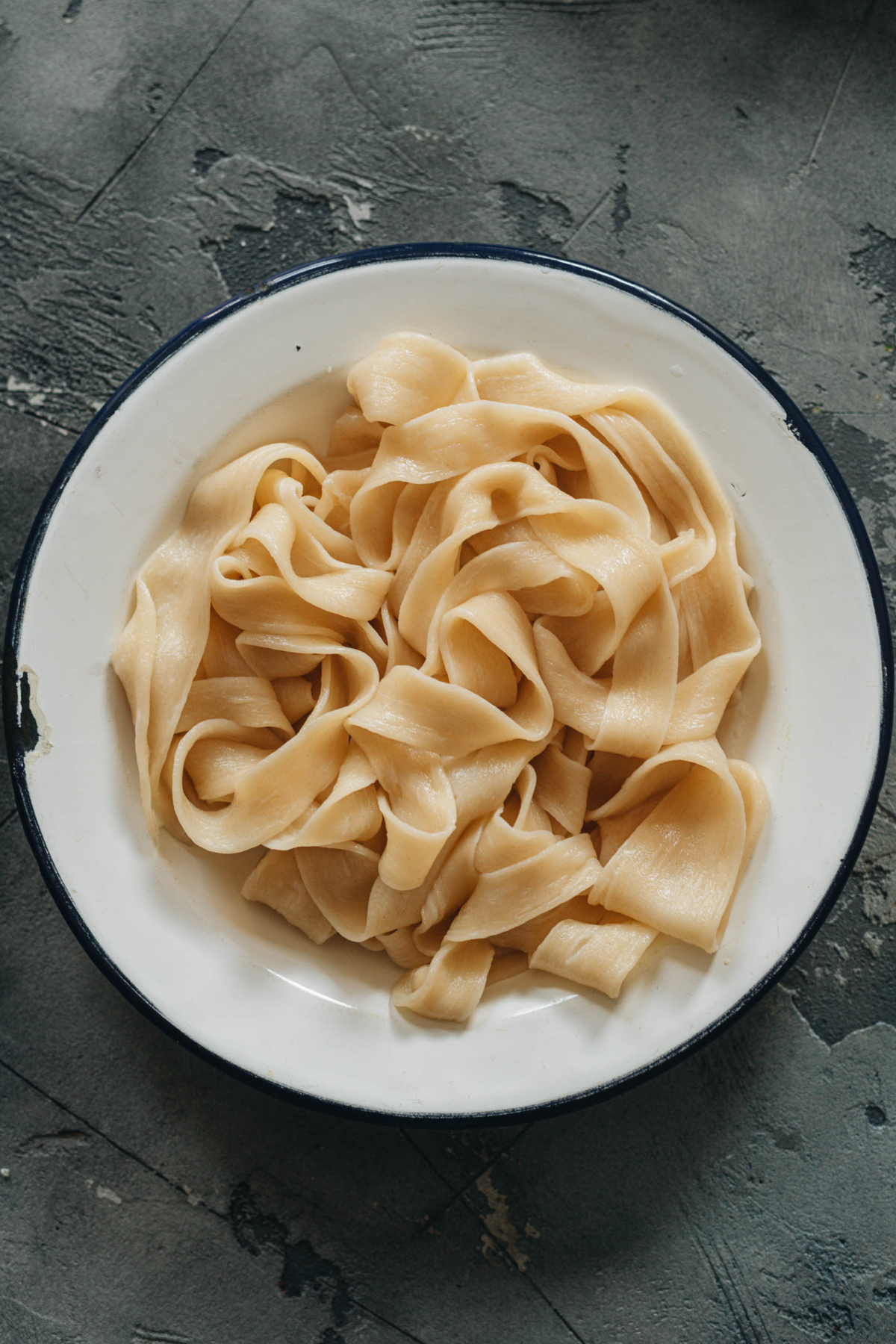
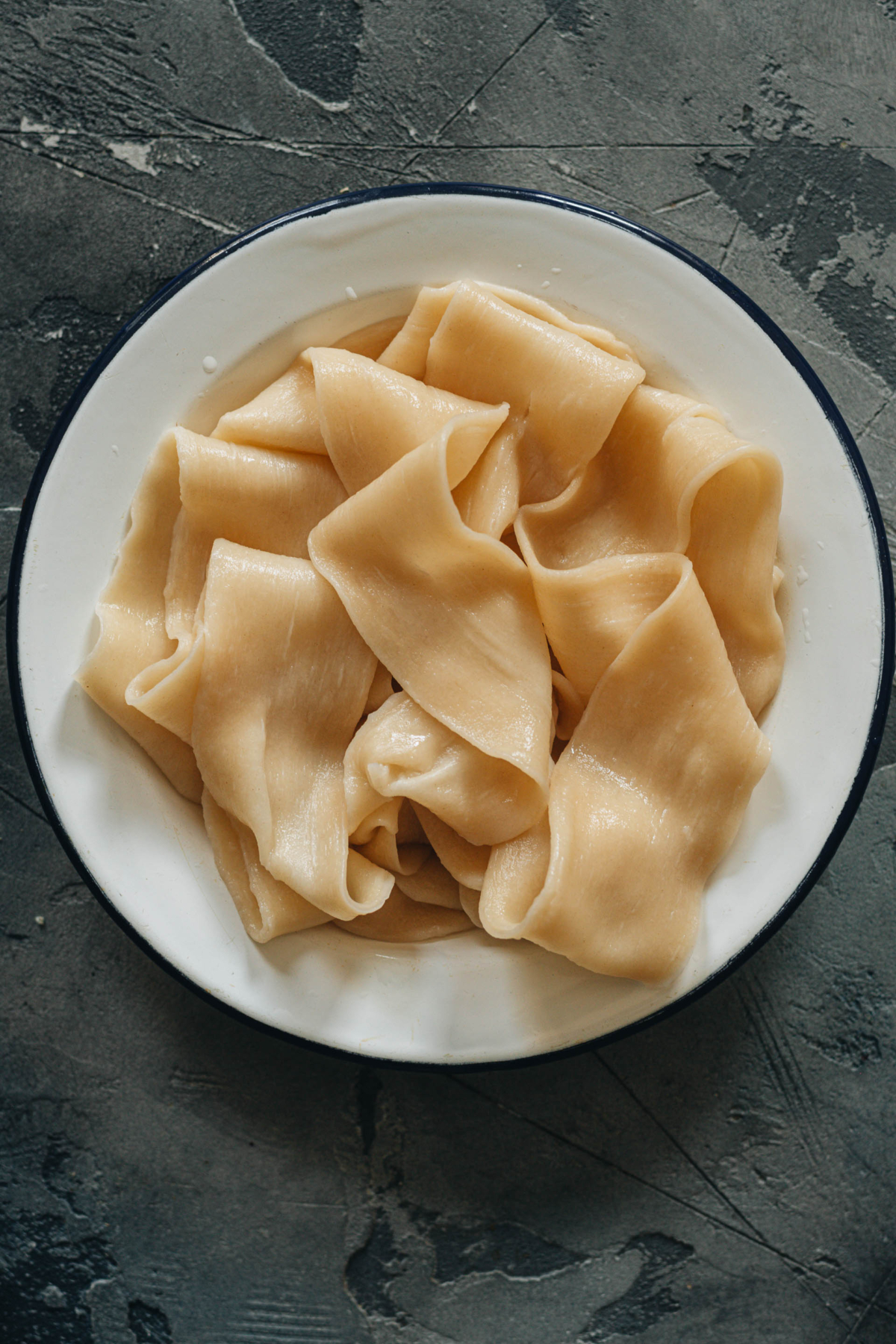
(3) Pull the noodles
- First, you need to cut the dough according to the width of the noodles you want to make.
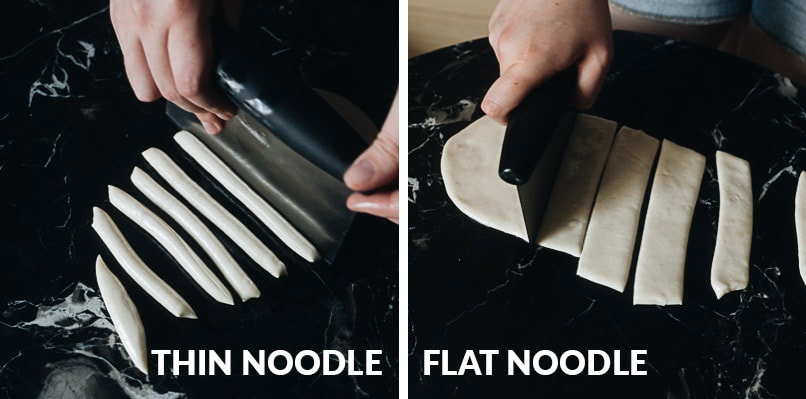
PS: It’s important to keep the cut noodles covered with plastic wrap so they don’t dry out.
- The process of pulling the three types of noodles is the almost same – pull the dough into a thin strip with one motion, and keep pulling and bouncing on the table into a thin shape, then fold it, pull it, and bounce it again until it reaches the desired thickness (except for flat or wide noodles, which you don’t need to fold).
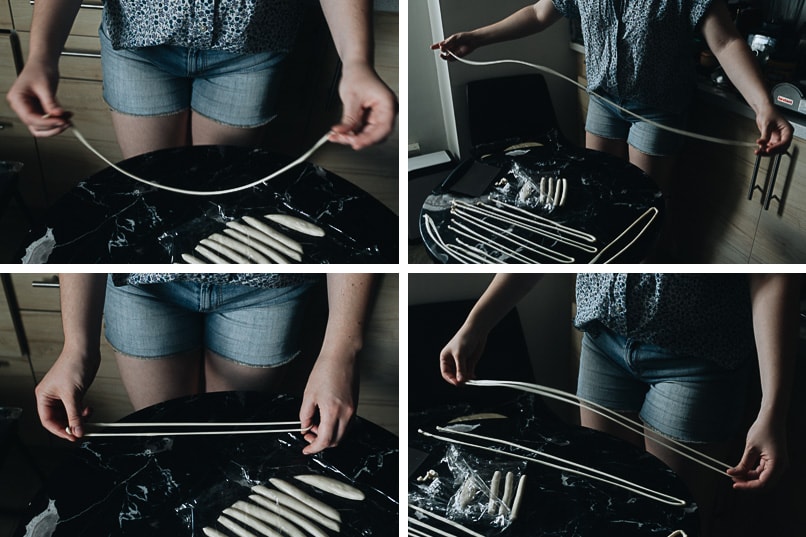
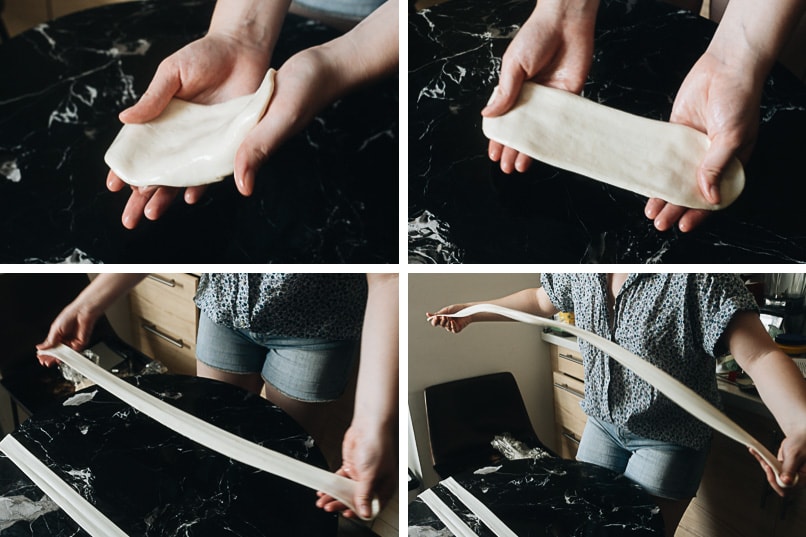
- Once you’ve pulled the noodles, rest them on the working surface without overlapping. If you have a small working surface, you can dust the noodles with flour so they don’t stick together if placed too closely together.
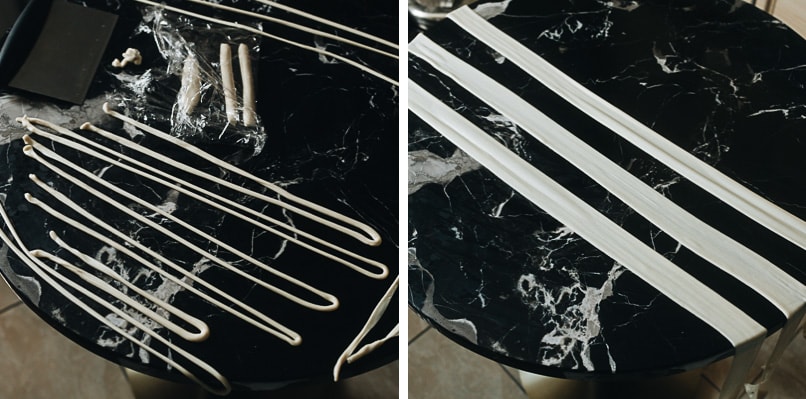
(4) Cook the noodles
- To cook the noodles, drop a few strands of noodle into the boiling water at a time and cook until they’re cooked through and springy. If you prefer the texture to be softer, boil them a bit longer.
- Once done, remove the noodles to a colander and rinse them with tap water to stop the cooking.
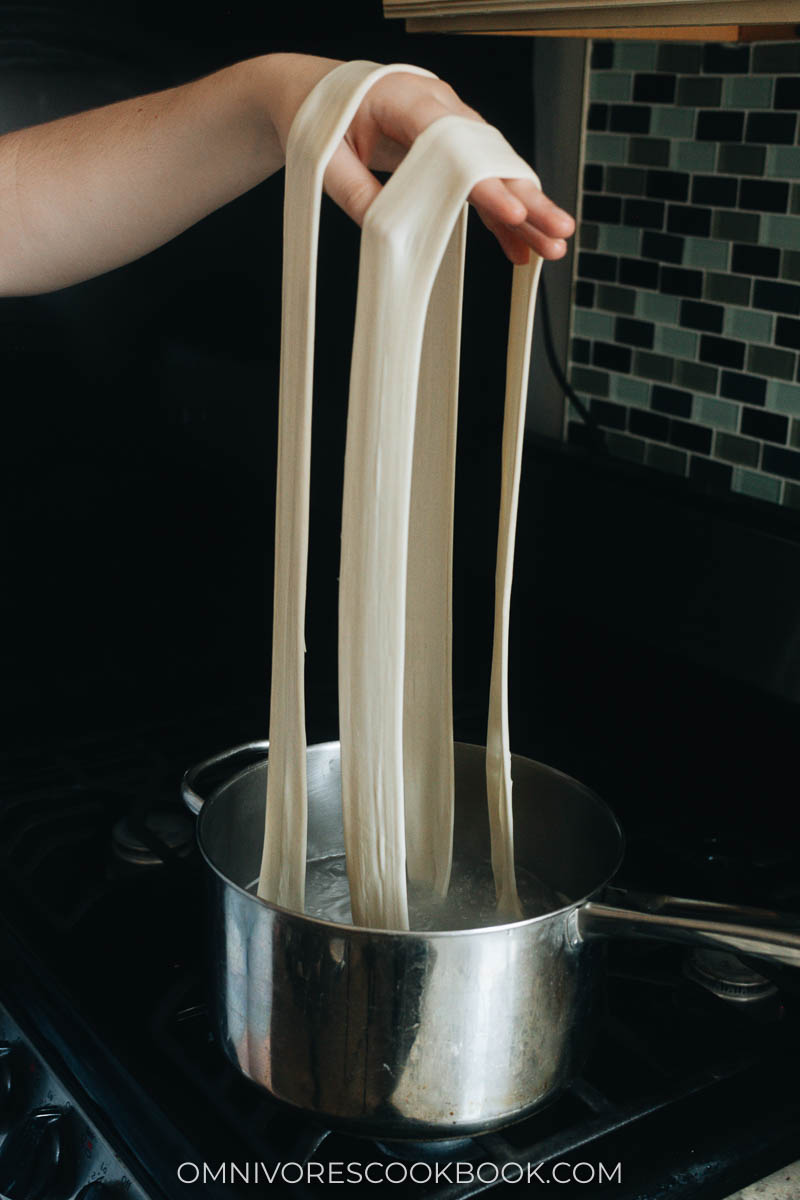
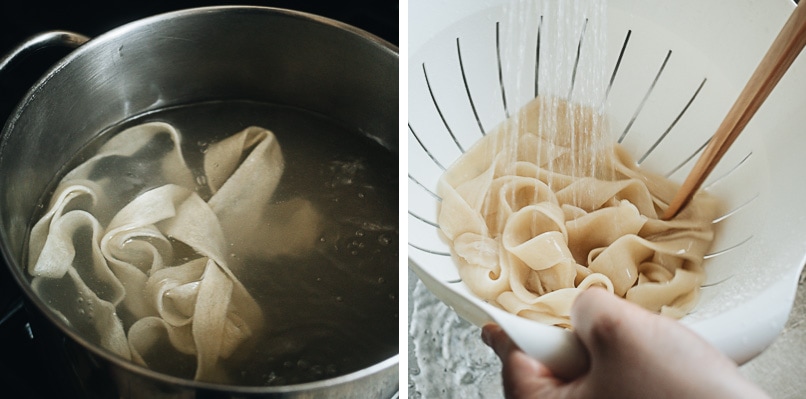
(5) Serve and store hand pulled noodles
The freshly made noodles can be enjoyed with a simple sauce and made into various noodle dishes including soup and stir fries.
Here are some ideas on how to use them:
- Cumin Lamb Noodles
- Vegetable Lo Mein
- Easy Soy Sauce Noodles
- Real Deal Sesame Noodles
- Dan Dan Noodles
- Da Pan Ji (Chicken Potato Stew with Noodles)
- Lanzhou Beef Noodles
- Biang Biang Noodles (Chinese Hot Sauce Noodles)
You can find detailed information in the recipe below on storage.
Frequently asked questions
Unfortunately, NO. It’s very important to cook the noodles immediately once you’ve pulled them. In fact, the pulled noodles should be dropped directly into boiling water (that’s how they do it at restaurants). If you want to store the raw noodles, you must use starch (or flour) to coat them so they won’t stick together. But the dough will change in texture during this process.
If you want to store raw noodles, check out my rolled noodles recipe.
YES! This is the best way to store them. You can slightly undercook the noodles if you plan on storing them. So they reach the perfect consistency once they’re reheated. You can see more notes on how to reheat in the recipe below.
Yes. Once you roll out the dough and let it rest at room temperature for 2 hours, you can cover the dough and move it to the fridge. Cut, pull, and boil the noodles when you plan to serve them.
Yes! The thin type of noodles works perfectly in stir fries and as lo mein noodles.
In this case, I recommend you slightly undercook the noodles, so they will achieve the perfect textures once stir fried.
We tested with various brands and types of flour and finally achieved a consistent result no matter what brand we were using.
In the pictures I used all-purpose flour from the King Author brand (11.7% protein content).
We also tried a mixture of 370 g (3 cups) of cake flour and 30 g (3 tablespoons) of bread flour. This mixture produces a slightly smoother dough (marginally). It’s possible to use different blend to achieve different texture, even 100% bread flour, but I do not recommend using 100% cake flour.
Back in China I used a Chinese-brand all-purpose flour. It required slightly more water (a bit more than 1 cup).
Using alkaline water in the noodle dough increases the chewiness of the texture and it doesn’t affect the pulling process. (It is the salt that makes the dough stretchy.) I found that even if you skip the alkaline water, you will produce a great result with a chewy texture (without the noodles getting too tough). So I decided to skip this ingredient, which makes the recipes a bit more complicated.
Yes, but you might need a bit of practice. If you decide to pull more than one noodle at a time, coat the dough with flour before pulling so the noodle strands don’t stick together.
Yes. It won’t affect the result much. Especially the 2nd resting. Once the dough is relaxed, it stays relaxed if you store it for hours before pulling.
Recipe update notes
I created this recipe back in 2015 while I was still living in China. It’s a family recipe and I created a short video to show the process.
Over the years I’ve received many readers’ positive feedback and questions. Moreover, I have since moved to the US and realized that all-purpose flour here is different from the ones in China (namely, they have more protein content). The old recipe still works but sometimes it does not produce consistent results depending on the brand of flour you use.
That’s why we decided to retest the recipe using various types of flour in the US, slightly refining the process to make the result more consistent and closer to perfect each time.
We also added instructions on making different shapes of noodles according to your suggestions.
Chinese Cooking Made Easy
Are you new to this website? This free email series is a great place to start. I’ll walk you through a few of my most popular recipes and show you how and why they work. You’ll quickly start to cook better Chinese food in your own kitchen.
Watch video
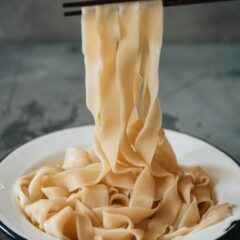
Easy Hand-Pulled Noodles
Ingredients
- 2 2/3 cup all-purpose flour (*Footnote 1)
- 1/2 teaspoon salt
- 1 cup water , room temperature
- Vegetable oil to coat the dough
Instructions
Make the dough by hand (Option 1)
- Combine the water and salt in a small bowl. Stir to dissolve the salt.
- Add the flour into a large bowl. Bit by bit, pour the water into the flour, mixing with a pair of chopsticks or a spatula as you go.
- Once all the water is added, the dough should be in shaggy threads with little/no dry flour in the bowl. Begin pressing the dough together. If you find the dough is too dry and there’s still dry flour that’s hard to incorporate into the dough, drizzle more water onto the dry flour and mix it again, until there’s no dry flour left. Knead the dough until a rough, firm ball is formed, about 2 minutes.
- Cover the bowl with plastic wrap and let it rest for 20 minutes.
- Once the dough is rested, knead it again until it becomes smooth, 1 to 2 minutes.
Make the dough using KitchenAid (Option 2)
- Mix the flour and salt in the bowl of the KitchenAid mixer and add the dough hook. Turn it to the mix setting. Slowly drizzle the water down the side, all along the bowl. This should take about 1 minute. Once the water is incorporated, turn to setting 2 and knead until a rough dough ball is formed, another 2 to 3 minutes.
First rest
- Cover the dough with plastic wrap and let it rest for 20 minutes.
Second kneading
- Either knead in the machine on setting 4 for 30 seconds or by hand for 1 to 2 minutes. Then shape the dough.
- (Optional) If you plan to store/freeze the dough, coat the dough with oil and store it in a sealed plastic bag. Refrigerate for up to 2 days or freeze for up to 3 months.
Shape the dough
- FOR THIN NOODLES: Divide the dough to halves and roll each dough into a 1/2” (1 cm) thick oval.
- FOR FLAT NOODLES: Divide the dough to halves and roll each and roll each dough into a 1/4” (1/2 cm) thick oval.
- FOR WIDE NOODLES: Cut the dough into 8 pieces. Roll each piece into approximately 3”x5” (8×13 cm) ovals, 1/4” (1/2 cm) high.
Second rest
- Coat the dough(s) generously with oil and cover with plastic. Let rest for 2 hours.
Pull and cook the noodles
- Bring a medium-sized pot of water to a boil.
- FOR THIN NOODLES: Cut long the longer side of the oval, slicing the dough into 1/2” (1 cm) wide strips and rolling each piece slightly to the side with each cut to prevent them from sticking together. Cover the cut pieces with the plastic again to prevent them from drying out. Starting with the first strip you cut off, pick it up on both ends. (*Footnote 2) In one swift motion, tug the noodle about an arm’s length and gently bounce it on the working surface once or twice until it forms a long, thin noodle. Rest the noodle on your working surface as you fold it over, so that both ends are in one hand. Hook the other side with your thumb. Give it a couple light tugs and bounces until the noodles get longer and reach the desired thin shape. Then pull off the thick ends collected in one hand and lay the noodle out on the working surface. Repeat with the rest of your noodles.
- FOR FLAT NOODLES: Cut along the longer side of the oval, slicing the dough into 1 1/2” (3 cm) wide strips. Cover the cut pieces with the plastic again to prevent from drying out. Starting with the first strip you cut off, pick it up on both ends. (*Footnote 2) In one swift motion, tug the noodle to about an arm’s length and gently bounce it on the working surface once or twice. Rest the noodle on your working surface for 10-20 seconds, then give it a couple extra-light tugs and bounces until it forms a flat long noodle. Then pull off the thick ends and lay the noodle out. Repeat with the rest of your noodles. Drop the noodles into the boiling water, a few at a time, and cook for 1 to 1.5 minutes.
- FOR WIDE NOODLES: One at a time, grip the short ends of a strip (*Footnote 2) and pull it apart in one swift motion until the dough feels taut. It should be between 1 to 2 feet. Bounce it on the table a couple times. Pull off the thick ends and lay the noodle out, covering it with plastic to prevent drying out.
Cook the noodles
- Drop the noodles, a few pieces at a time, into the boiling water and cook for 1 to 1.5 minutes, until tender but still with a chewy texture. Do not cook too many noodles at a time! It’s hard to control the texture that way and the noodles might stick together.
Storage
- Store the cooked noodles: If you plan on reheating, you can slightly undercook the noodles (to al dente) to create a better texture once reheated. Store the noodles in an airtight container or a ziplock bag in the fridge for up to 3 days or in the freezer for up to 3 months.
- For frozen/refrigerated dough; let the frozen dough thaw in the fridge overnight. Transfer the refrigerated dough to room temperature. Rest for 2 hours. The dough will become super soft and can be gently shaped, rested for another 10 minutes or so, and pulled. Cook according to the instructions above.
Reheating cooked noodles
- To reheat, bring a pot of water to a boil and add the cooked noodles. Separate with a pair of chopsticks and cook until the noodles are just heated through.
- For a quicker and lazier reheating method (for leftovers), reheat the refrigerated noodles in the microwave until heated, then quickly rinse the noodles with tap water in a colander. Drain the water thoroughly before serving.
- If you plan to use the thin noodles for fried noodles, you don’t need to reheat them before using. Thaw them if frozen. Then run the noodles with tap water in a colander and separate gently with chopsticks. Drain thoroughly before using for stir fried noodles.
Notes
- If you do not have all-purpose flour, you can use 370 g (3 cups) cake flour + 30 g (3 tablespoons) bread flour instead.
- If you do not have a lot of space for the pulled noodles or if you’d like to try pulling a few noodles at a time (it takes practice but it’s possible!), you should dust the noodle dough with extra flour to prevent them from sticking together.
Nutrition

Did you make this recipe?
I’d love to hear how it turned out for you! Please take a moment to leave a 5-star rating ⭐️ and share your thoughts in the comments further down the page. It really helps others discover the recipe too.
Lilja Walter is a part of the Omnivore’s Cookbook team and worked closely with Maggie to develop and test this recipe.

Dave B
Made this and it turned out well; thin noodle version. They were thicker than I would have liked, though. If I pulled more, they broke. Any tricks to making them thinner? Maybe cut the strips narrower in the first place, or roll thinner?
Maggie Zhu
You can cut the strips narrower, and let them rest a bit longer. That being said, even the thin noodles won’t be super thin like somen (or angel hair).
Jessica
Is there a video where we can (slowly) see how to do the pulling?
Maggie Zhu
I’m working on a video right now 🙂
AliceK
Hi, Maggie! I am resting my noodle dough right now. My question is, do you throw away the thick ends of the noodles after they are pulled? That seems very wasteful to me. Or can they be put into ball, rested, andcused to make more noodles?
Maggie Zhu
I usually knead them together, rest them, then stretch to small strands of noodles. If you don’t mind the look of them, you can totally use the ends of the dough as well!
Aga
Great recipe! Is there any chance to make noodles that are gluten free? What flour to use, i am at loss and can’t have gluten 🙁
Maggie Zhu
You can make rice noodles that do not contain gluten. I don’t have a recipe yet but you can find them by googling it.
Ali Z.
Thanks so much for this recipe! I have tried a lot of hand pulled noodle recipes to various degrees of success but this one was by far the easiest and simplest with the best results! I do think that pulling noodles does take a bit of practice, and while i can’t quite do what you recommend with stretching them quickly, i can get them quite thin by gradually stretching and bouncing. But I ended up with a great medium thickness noodle that pairs well with soups! I would recommend to other people that can’t pull as thin as you’d like, to salt the boiling water that you boil the noodles in so that the noodles have more flavor since broth can’t necessarily penetrate it deeply.
Scott Wick
i made the extra wide ones. Good to make while you have other things going on because of the wait times. They were amazing! wondering if they could be frozen before the slap and cook.
Maggie Zhu
I’ve never tried freezing these but I think it’s possible. Once fully thawed, the dough should still be very tender and easy to stretch out.
Anouk
Love the attention to detail and the whole overall recipe, thank you so much for sharing your family’s recipe!!
Damarie
This was so awesome! My whole family loved the noodles…even my picky kids 😆 They were so eager to eat that I didn’t stop to take pics, but they’ve already requested an encore so I’ll make sure to take pics next time!
SANDIE
Thank you for such clear instructions. I’ve made these a few times now, and while they look a bit wonky and not as pretty as yours, they are fantastic! I paired these with the homemade chili oil, ma po tofu, dry fried long bean, orange chicken, and beef w/broccoli. All your recipes, all great. What a feast!!
Cynthia S.
Wow! This is a fun recipe that concludes with fresh restaurant-quality noodles! Thank you for creating this recipe. it is flawless!
I tried making hand-pulled noodles yesterday using another recipe that used the same ingredients but a different technique and it was nothing in comparison to this. Kudos!
Paul
I’ve used other recipes that require resting for many hours. This recipe is the one to use! It is faster, easier and pulling is actually fun! THANK YOU!
Paul
Is the third resting after pulling? This is not clear. How long to rest?
Maggie Zhu
Hi Paul, you don’t need the third resting since the noodles are ready to cook as soon as they’re pulled and stretched out. You should cover them with plastic to prevent drying out when you’re pulling the rest noodles. But ideally you can even cook them one at a time when you pull them (restaurant chefs use this practice, but you need to work fast enough).